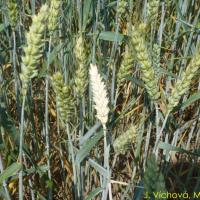Take-all
Gaeumannomyces graminis
Gaeumannomyces graminis:
Gaeumannomyces graminis is a soilborne fungus that causes take-all root rot, a significant disease affecting various grasses, including important cereal crops such as wheat, barley, and oats. Here's an informative description:
Symptoms:
- Root Rot: The fungus infects the roots, causing necrosis and rotting of the root system.
- Stunted Growth: Infected plants often exhibit stunted growth due to impaired nutrient and water uptake.
- Yellowing: Foliar symptoms include yellowing of the leaves, which may progress to general wilting.
- White Mycelium: In advanced stages, a white mycelial mat may be visible on the roots.
Identification:
- Root Inspection: Examine the roots for signs of necrosis, rotting, and the presence of a white mycelial mat.
Disease Cycle:
- Survival: The fungus can survive in soil and plant debris.
- Infection: The pathogen infects the roots, establishing itself in the root system.
- Secondary Spread: The fungus produces spores that can lead to secondary infections.
Management:
Cultural Practices:
- Crop Rotation: Rotate crops to reduce the buildup of the pathogen in the soil.
- Resistant Varieties: Planting resistant varieties, when available, can be an effective strategy.
Soil Management:
- Well-Drained Soil: Ensure well-drained soil to reduce conditions favoring the pathogen.
- Organic Amendments: Incorporate organic amendments to improve soil structure and microbial diversity.
Chemical Control:
- Seed Treatments: Application of fungicidal seed treatments may be considered to protect seedlings.
Regular Monitoring:
- Field Scouting: Regularly monitor fields for symptoms of take-all root rot, especially in susceptible crops.
Post-Harvest Practices:
- Residue Management: Manage crop residues after harvest to reduce overwintering sites for the fungus.








